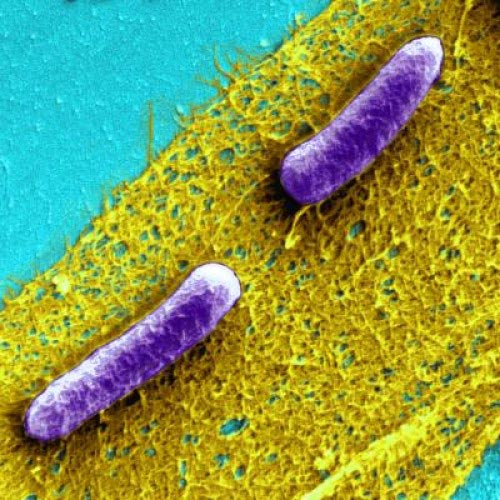Ordinarily, biofilms—the slimy but tough structures assembled by bacteria—raise just one question: How do we get rid of them? Hunkered within their biofilm castles, bacteria sustain all manner of mischief, from the formation of dental plaque to the impairment of wound healing to the spread of infections. So it is curious to hear that biofilms may actually be used to do some good. Instead of giving bacteria a base from which to inflict harm, a biofilm may serve as a tiny factory, assembling desirable materials.
The idea of using bacteria as tiny factories is nothing new. Bacteria are used all the time to pump out soluble molecules such as drugs or fuels. Bacteria, however, are typically limited to producing molecular building blocks. They generally aren’t used to assemble the building blocks into larger structures.
Where individual bacteria fall short in this regard, biofilms may excel. During biofilm production, the proteins that are pumped out by individual cells self-assemble in the extracellular space, creating tangled networks of fibers that essentially glue the cells together.
Taking advantage of this self-assembly mechanism, a team of researchers at the Wyss Institute for Biologically Inspired Engineering at Harvard University has developed a novel protein engineering system called BIND. Using BIND, which stands for Biofilm-Integrated Nanofiber Display, the team said biofilms could be tomorrow’s living foundries for the large-scale production of biomaterials that can be programmed to provide functions not possible with existing materials.
The Wyss researchers published a proof-of-concept report September 17 in Nature Communications, in an article entitled, “Programmable biofilm-based materials from engineered curli nanofibres.” In this report, the authors described how they genetically appended peptide domains to the amyloid protein CsgA, the dominant proteinaceous component in Escherichia coli biofilms.
“These engineered CsgA fusion proteins are successfully secreted and extracellularly self-assemble into amyloid nanofiber networks that retain the functions of the displayed peptide domains,” wrote the authors. “We show the use of BIND to confer diverse artificial functions to the biofilm matrix, such as nanoparticle biotemplating, substrate adhesion, covalent immobilization of proteins or a combination thereof.”
The team demonstrated an ability to fuse 12 different proteins to the CsgA protein, with widely varying sequences and lengths. This means in principle that they can use this technology to display virtually any protein sequence—a significant feature because proteins perform an array of impressive functions from binding to foreign particles to carrying out chemical reactions, transmitting signals, providing structural support, and transporting or storing certain molecules.
“Until recently there was not enough cooperation between synthetic biologists and biomaterials researchers to exploit the synthetic potential of biofilms this way,” said Wyss Institute Core Faculty member Neel Joshi, Ph.D., the study’s senior author. “We are trying to bridge that gap.”
According to the Wyss researchers, their approach to biofilm engineering goes beyond the development of generic tools to control biofilm formation. Instead, they say, they are developing the means to alter the composition of the extracellular material itself, essentially turning it into a self-replicating production platform to churn out whatever material they wish to produce.
“The foundational work Neel and his team are doing with biofilms offers a glimpse into a much more environmentally sustainable future where gargantuan factories are reduced to the size of a cell that we can program to manufacture new materials that meet our everyday needs—from textiles to energy and environmental clean-up,” said Wyss Institute Founding Director Don Ingber, M.D., Ph.D.
For now the team has demonstrated the ability to program E. coli biofilms that stick to certain substrates, such as steel, others that can immobilize an array of proteins or promote the templating of silver for construction of nanowires.



